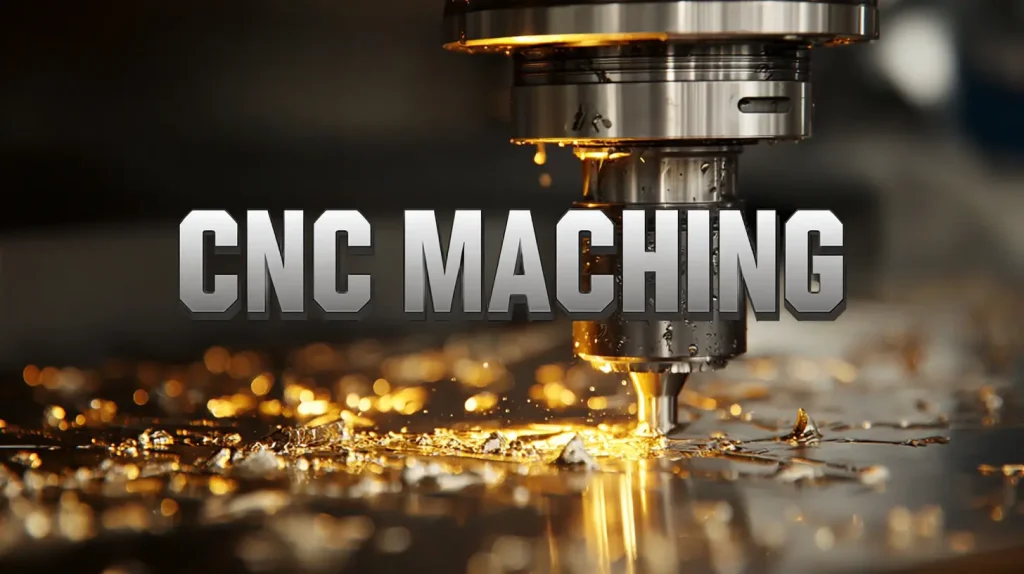Top CNC Machining Trends for Product Designers in 2025

CNC machining continues to be a cornerstone of modern product development, enabling designers to move from digital models to precision-engineered components quickly and accurately. In 2025, the CNC machining landscape is evolving rapidly — powered by AI, sustainable practices, digital integration, and hybrid manufacturing technologies.
For product designers, understanding these trends is critical to creating manufacturable, cost-effective, and future-ready designs.
1. AI, Machine Learning, and Smart Process Control
Artificial intelligence and machine learning have become integral to CNC machining systems. According to a 2025 MarketsandMarkets report, AI-driven CNC machines are projected to grow at a CAGR of 22.3% between 2024–2028, reflecting a strong shift toward intelligent process automation.
Key Capabilities
-
Predictive Maintenance: Real-time tool wear monitoring extends tool life by 20–40%.
-
Adaptive Feed Optimization: Machines adjust cutting parameters autonomously, improving productivity by up to 25%.
-
Defect Detection: Integrated vision systems can reduce part rejection rates by 15–30%.
| AI-Driven CNC Function | Performance Gain (2025 Avg.) | Impact on Design |
|---|---|---|
| Predictive Tool Wear | +35% Tool Life | Allows tighter tolerances and longer production runs |
| Adaptive Feed Control | +25% Throughput | Enables faster prototyping and small-batch iteration |
| Real-Time Defect Monitoring | −30% Defect Rate | Supports precision-critical parts (medical, aerospace) |
Design Tip: Provide rich metadata in CAD files (material, finish, tolerance requirements). AI-assisted CAM systems interpret these attributes to automatically generate optimized toolpaths.
2. Multi-Axis and Hybrid Manufacturing
Five-axis machining is now standard in advanced prototyping facilities, while hybrid additive-subtractive machines are redefining design freedom.
-
5-Axis Market Growth: Expected to reach USD 5.2 billion by 2025 (Grand View Research).
-
Hybrid Machine Adoption: Increasing by 18% annually, especially in aerospace and tooling industries.
| Machine Type | Typical Accuracy (±μm) | Key Advantage | Design Implication |
|---|---|---|---|
| 3-Axis | ±20–40 | Low cost, simple geometries | Best for flat or prismatic parts |
| 5-Axis | ±5–10 | One-setup complexity reduction | Allows undercuts, curved surfaces |
| Hybrid (Additive + CNC) | ±10–20 | Combines near-net shaping and finishing | Enables internal channels and lightweight lattices |
Design Tip: Use hybrid machining for parts combining internal cavities or lattice structures with precision outer surfaces — e.g., aerospace brackets or cooling housings.
3. Sustainability and Green Machining
Environmental sustainability is no longer optional. In 2025, more than 45% of CNC facilities have implemented energy-efficient spindles, minimum quantity lubrication (MQL), or coolant recycling systems.
Sustainable Machining Data
-
Energy Savings: High-efficiency servo motors cut energy use by 15–25%.
-
Coolant Reduction: MQL lowers fluid consumption by up to 90%.
-
Material Recycling: Aluminum chip recovery rates exceed 95% in leading facilities.
| Green Practice | Reduction Achieved | Design Consideration |
|---|---|---|
| MQL or Dry Machining | 90% less coolant | Simplify heat management in part geometry |
| Recycled Materials | 30–40% CO₂ reduction | Choose common alloys with strong recyclability |
| Energy-Efficient Machines | 20% less power use | Favor simpler setups, fewer re-clamps |
Design Tip: Avoid unnecessary over-tolerancing or deep pocketing that increases energy and tool wear. Optimize geometry for material removal efficiency.
4. Digital Thread, IoT, and Smart Factory Integration
In 2025, CNC machines are no longer isolated — they’re connected to cloud-based digital manufacturing ecosystems. The “digital thread” links CAD, CAM, MES, and ERP systems for seamless data exchange.
-
Connected CNC Installations: 60% of new machines are IoT-enabled.
-
Data Transfer: Real-time machining data feeds into digital twin simulations for performance feedback.
| Digital Capability | Adoption Rate (2025) | Designer Benefit |
|---|---|---|
| IoT Machine Connectivity | 60% | Enables feedback on machining accuracy and cycle time |
| Digital Twin Simulation | 40% | Allows virtual prototyping and DFM testing |
| Cloud CAM Collaboration | 55% | Simplifies design-to-production workflows |
Design Tip: Incorporate real-time manufacturing feedback loops. When machining feedback (vibration, temperature, tool force) is available, designers can refine tolerances based on actual performance data.
5. Advanced Materials and Tooling
CNC technology continues adapting to the growing use of advanced alloys and composites. Tooling innovations in 2025 make it possible to machine harder materials faster and more precisely.
| Material | Hardness (HB) | Recommended Cutting Speed (m/min) | Typical Tolerance (μm) |
|---|---|---|---|
| Aluminum 6061 | 95 | 300–600 | ±10 |
| Stainless Steel 304 | 180 | 80–120 | ±15 |
| Titanium Ti-6Al-4V | 330 | 40–70 | ±8 |
| Inconel 718 | 430 | 25–50 | ±6 |
Technical Insight:
-
Tool Coatings: TiAlN and DLC-coated tools offer 2–3× longer life than uncoated tools.
-
Coolant Delivery: High-pressure (≥70 bar) systems improve chip evacuation and reduce heat in titanium machining.
Design Tip: For titanium or Inconel, design with larger internal radii (≥3 mm) to minimize tool stress and heat buildup.
6. On-Demand and Small-Batch Production
Agile manufacturing is booming. According to Statista 2025, on-demand CNC production now accounts for 32% of total machining orders, up from 18% in 2022.
| Production Type | Typical Lead Time | Best For | Design Guidance |
|---|---|---|---|
| High-Volume CNC | 2–4 weeks | Mass parts | Optimize for repeatability |
| On-Demand CNC | 3–5 days | Prototypes & low-volume runs | Simplify features and setups |
| Hybrid (CNC + 3D Printing) | 1–3 days | Complex prototypes | Combine additive and subtractive |
Design Tip: Optimize designs for one-setup manufacturability. Reducing the number of tool changes or fixturing steps lowers both cost and cycle time — ideal for short production runs.
7. In-Process Quality Control and Automation
Automated inspection has become standard in 2025. Coordinate measuring machines (CMMs) and laser scanning probes are now integrated into machining centers, achieving dimensional verification without removing the part.
| Inspection Method | Accuracy (μm) | Cycle Time Impact | Best Use Case |
|---|---|---|---|
| On-Machine Probing | ±3 | +2–5% | Real-time in-line inspection |
| Optical Vision Systems | ±5 | +1–2% | High-speed surface checks |
| 3D Laser Scanning | ±10 | +3–6% | Complex geometries, freeform surfaces |
Design Tip: Ensure all critical features are accessible for probing or scanning. Avoid deep hidden cavities that hinder inspection accessibility.
8. The Evolving Role of Product Designers
CNC machining’s digital transformation changes how designers work. A survey by SME Manufacturing Insights 2025 found that 70% of product designers now collaborate directly with machinists during the early design phase.
Key Shifts
-
From CAD to CAM Awareness: Designers increasingly simulate toolpaths.
-
Cross-Disciplinary Skills: Understanding cutting speeds, feeds, and machine axes improves DFM results.
-
Data-Driven Design: Designers use machine analytics to optimize future parts.
Practical Parameters to Know (2025 Baseline)
| Machining Parameter | Typical Range (2025) | Design Consideration |
|---|---|---|
| Spindle Speed | 8,000 – 30,000 RPM | Impacts achievable surface finish |
| Feed Rate | 100 – 800 mm/min | Affects tool marks and cycle time |
| Positional Accuracy | ±2 – 10 μm | Defines tolerance stack-up |
| Surface Finish (Ra) | 0.2 – 1.6 μm | Dependent on toolpath & material |
Conclusion
CNC machining in 2025 is smarter, greener, and more integrated than ever. For product designers, the key is designing with these technologies in mind — embracing data-driven decisions, collaborating early with machinists, and optimizing geometry for both performance and manufacturability.
By leveraging these trends, designers can reduce lead times by up to 40%, cut waste by 30%, and produce prototypes that transition seamlessly into full production.
FAQs
1. What are the biggest CNC machining trends for product designers in 2025?
The key trends include AI-driven smart machining, multi-axis and hybrid manufacturing, sustainable practices, IoT connectivity and digital thread integration, advanced materials and tooling, small-batch/on-demand production, and in-process quality control automation.
2. How does AI impact CNC machining for product design?
AI enables predictive maintenance, adaptive toolpaths, and defect detection. Designers can rely on higher precision, reduced defect rates, and faster prototyping, allowing them to push more complex designs with confidence.
3. What is hybrid CNC machining, and why is it important?
Hybrid machining combines additive (3D printing) and subtractive (CNC) processes in one machine. It allows designers to create complex internal structures and lightweight parts while finishing critical surfaces with high precision.
4. How do sustainability trends affect CNC design choices?
Sustainable machining practices, such as dry machining or minimum quantity lubrication (MQL), influence material selection, part geometry, and tolerance choices. Designers can reduce waste and energy consumption by optimizing features and simplifying setups.
5. What materials are trending in CNC machining for 2025?
Advanced materials like titanium alloys, Inconel, high-strength stainless steels, and engineered composites are increasingly used. These require specialized tooling, coatings, and cutting strategies, which designers should consider early in the design process.
6. How does IoT and digital thread integration benefit product designers?
Connected CNC machines allow real-time data collection and digital twin simulation. Designers can optimize part geometry based on actual machining feedback, improving manufacturability, tolerances, and overall quality.
7. Can CNC machining handle small-batch or on-demand production effectively?
Yes. On-demand CNC production is growing, enabling rapid prototyping and low-volume production with reduced lead times. Designers should focus on one-setup manufacturability and minimal fixturing to optimize cost and speed.
8. How do in-process inspection and quality control trends affect design?
Automated probing, vision systems, and laser scanning allow designers to achieve tighter tolerances. Critical features should be accessible for inspection, and over-complicated geometries may increase cost and cycle time.
9. How should product designers collaborate with CNC machinists in 2025?
Early collaboration is essential. Designers should provide detailed CAD metadata, consider machinability, understand machine capabilities, and leverage simulation tools to ensure designs are manufacturable and optimized for cost and speed.
10. What parameters should designers be aware of for 2025 CNC machining?
Key parameters include spindle speed (8,000–30,000 RPM), feed rate (100–800 mm/min), positional accuracy (±2–10 μm), and achievable surface finish (Ra 0.2–1.6 μm). Understanding these helps designers optimize tolerances, surface finishes, and overall part performance.



